Welshpool is a market town situated in the historic county of Montgomeryshire, some four miles from the Wales – England, near the River Severn. The town lies in a prominent position along the main road from Newtown to Oswestry. The community includes Cloddiau and Pool Quay, and incorporates the fine Powis Castle and its estate, which lie just to the south. The men and women of the town and surrounding area who fell during both World Wars are commemorated on the Welshpool and District War Memorial, which is situated in a memorial garden along a steep flight of steps running from Church Street to the grounds of St. Mary’s Church, in a prominent position overlooking the town. The memorial takes the form of a series of sixteen tablets, set into a semi-circular wall, which curves around an elaborately carved lantern cross. This page commemorates the men named on a war memorial which is now situated inside New Street Methodist Church, Welshpool. The memorial originally came from another closed Church and had ended up being stored in a cupboard for several years, before being restored and erected in New Street Church. It commemorates twelve parishioners who fell during the Great War.
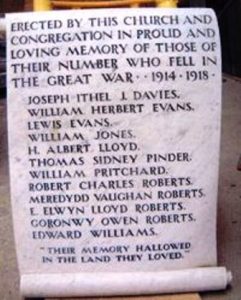
Erected by this church and
congregation in proud and
loving memory of those of
their number who fell in
the Great War 1914 – 1918
Joseph Ithel Jehu Davies, Second Lieutenant, Royal Welsh Fusiliers. Joseph was born on 10 August 1894, the son of Joseph Henry Davies and Sarah Evans Davies (nee Morris), of Ty Coch, Welshpool. He was educated at Welshpool Grammar and County Schools before entering Armstrong College, Durham University, where he graduated BSC. Joseph was a member of the University OTC and excelled in sports. He was commissioned into the 8th Battalion, Royal Welsh Fusiliers on 16 December 1914 and was drafted to France in October 1915, joining the 1st Battalion, Royal Welsh Fusiliers. The battalion was attached to 22 Brigade, 7th Division and was holding the Cambrin Sector, near Loos. The Division moved to the Givenchy Sector soon afterwards, remaining there until December when it moved to Montagne to carry out a course of instruction. At the end of January 1916, the 7th Division moved south to the Somme, taking over a section of the line near The Citadel, Facing Fricourt. It remained here over the coming months and on 1 July 1916 took part in the opening assault of the Battle of the Somme, capturing the village of Mametz, one of the few successes of the day. The Division then fought at the Battle of Bazentin Ridge, and the Attacks on High Wood, playing a successful part in the ‘dawn attack’, and were also the first troops into High Wood. By the beginning of September, the 7th Division was in the line at Longueval Alley, preparing to launch an assault on the strongly defended village of Ginchy. Joseph was given command of D Company, after Captain Jones was invalided with shellshock and on the morning of 3 September 1916 led his new command forward under the cover of an artillery barrage to take part in the assault. Joseph was mortally wounded that day, during hand-to-hand combat with a party of Germans and died soon afterwards. The 22-year-old is buried in Delville Wood Cemetery, Longueval, France. There is a memorial to him in Christ Church Churchyard at Welshpool.

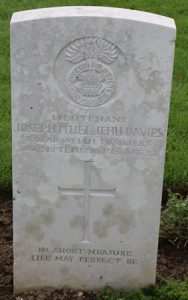
Lewis Evans, Private, 1002, Royal Welsh Fusiliers. Lewis was the son of Robert and Catherine Lewis, of Gornant Uchaf, Dyffryn. He enlisted at Welshpool into the 7th Battalion, Royal Welsh Fusiliers. The battalion was a Territorial unit, which mobilised for war at Newtown in August 1914, as part of North Wales Brigade, Welsh Division and moved to Conway until the end of the month, before moving to Northampton. In December the Division moved to Cambridge and then in May 1915 to Bedford, where the Division was numbered and the formation became 158 Brigade, 53rd (Welsh) Division. On 19 July 1915 the entire Division sailed from Devonport for Imbros and on 9 August 1915 landed at Suvla Bay. The infantry moved off the beaches into the bush, but due to a lack of maps and no knowledge of the terrain, many of the units became disorientated, and the situation became chaotic. Lewis was killed in action during heavy fighting on the following day, 10 August 1915, aged 22. He has no known grave and is commemorated on the Helles Memorial, Gallipoli.
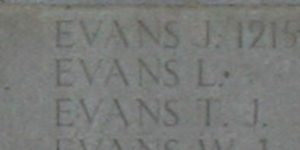
William Herbert Evans, Private, 7851, King’s Shropshire Light Infantry. William was the son of Edward and Ann Evans, of Welshpool. He had enlisted into the King’s Shropshire Light Infantry as a young man and had served for several years before leaving the army in 1908, becoming a Postman at Wrexham. As a former soldier, William was mobilised from the Army Reserve soon after the outbreak of war and married Mary Emily Owen, of Pwllyglo, Welshpool, at Wrexham on 29 September 1914, just before entraining for Pembroke Dock to join the 3rd Battalion, King’s Shropshire Light Infantry. The battalion was the regiments reserve unit and was on garrison duty at Pembroke Dock until moving to Edinburgh in November 1914. During March 1915 the battalion moved back to Pembroke Dock. William embarked for France on 19 May 1915, joining the 2nd Battalion, King’s Shropshire Light Infantry at Busseboom on 21 May. The battalion was attached to 80 Brigade, 27th Division, which was holding the line at Hooge and Railway Wood and was enjoying a short rest from duties in the front line following heavy fighting during the Second Battle of Ypres. On 24 May 1915 the Germans launched a poison gas attack against the 28th Division and the 4th Division, so the men of the 2nd KSLI were roused from their tents and ordered back into the line, marching via the line of the Ypres to Roulers railway. At dawn the following day, 25 May 1915, the battalion launched an assault on Bellewaarde Farm, but suffered terrible casualties before being forced to withdraw. William was among around 200 men killed during the failed assault that morning. The 39-year-old has no known grave and is commemorated on the Ypres (Menin Gate) Memorial, Belgium. His widow, Mary, died at Welshpool in 1923.
William Jones, Private, 10439, South Wales Borderers. William was the son of Anne Jones, of Lower Drifth, Churchstoke. His brother, Alfred, lived in Beguildy, where he worked as a farm hand. William was a regular soldier, and was serving with the 1st Battalion, South Wales Borderers at the outbreak of war. He disembarked in France on 9 November 1914 to join the battalion, which had been in France with the 1st Division since 13 August, and joined the battalion at Ypres, where it had been moved following the Battle of the Aisne. The task for the 1st Division at Ypres was a difficult one. The Germans plan, the Schlieffen Plan, involved a drive through Belgium to cut off the Channel ports, so the Allies had built a defensive line east of the city of Ypres, to stop this from happening. The division suffered heavy casualties at the fighting at Langemarck from 21-24 October, and the 1st SWB, together with the 2nd Welsh and 2nd Worcester’s, gained fame for holding the line at Gheluvelt following an overwhelming German attack on 31 October 1914. William joined the battalion at Outtersteene as part of a large number of drafts sent out to rebuild the battered battalion after its ordeals. He is officially recorded as being killed in action on 21 December 1914, although according to the battalion war diary, the battalion did not return to action until the following day, during an attack at Festubert. William has no known grave and is commemorated on the Le Touret Memorial, Richebourg-L’avoue, France. He is also commemorated on the Beguildy War Memorial.
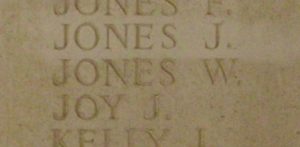
Hugh Albert Lloyd, Private, 5777, Royal Welsh Fusiliers. Hugh was the illegitimate son of Ann Lloyd, of Bryn Pistyll, Garthbeibio. He worked as a farm labourer at Llanerfyl prior to enlisting into the Royal Welsh Fusiliers at Wrexham on 22 July 1898. Hugh served with the 1st Battalion, Royal Welsh Fusiliers during the Boer War of 1899-1901, and in 1903 was posted to the 2nd Battalion, Royal Welsh Fusiliers, embarking with the battalion for India the following year. He also saw service in Burma with the battalion, until it returned to England in 1909, and remained with the battalion over the coming years. Hugh embarked for France with the 2nd Battalion, Royal Welsh Fusiliers on 13 August 1914. The battalion was initially placed on Lines of Communication at Rouen, before joining 19 Brigade at Valenciennes, taking part in the retreat to the Marne with the BEF. Following the Battles of the Marne and the Aisne, 19 Brigade moved to Flanders with the BEF, and eventually took over the La Boutillerie sector after becoming attached to the 6th Division. On 19 October the 2nd RWF marched to Laventie, billeting for the night before moving forward of Fromelles, where the men began to dig in. The battalion then moved and dug in a new defensive position around La Cordonnerie Farm, where it was hit by a German attack on 24 October, beating it off with just seventeen casualties. Attacks continued over the coming days, with especially fierce fighting on 26 October, but the battalion stood firm. Hugh was killed during another German attack here on 30 October 1914. The 38-year-old has no known grave and is commemorated on the Ypres (Menin Gate) Memorial, Belgium.
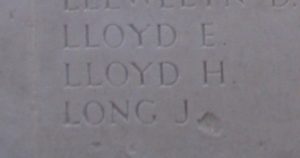
Thomas Sydney Pinder, Lance Corporal, PS/10092, Royal Fusiliers. Thomas was the son of Thomas and Sarah Jessie Pinder, of 10, Grosvenor Street, Newton Heath. He married Elsie Mary Turner at Manchester on 4 August 1915 and the couple moved to Havelock Terrace, Welshpool. Thomas enlisted at Welshpool into the army soon after the outbreak of war and early in 1916 was posted to the 8th Battalion, Royal Fusiliers. The battalion had been in France since May 1915, attached to 36 Brigade, 12th (Eastern) Division. The Division had taken part in the Battle of Loos, and the subsequent actions of the Hohenzollern Redoubt in September 1915 and had remained in the Vermelles sector over the winter. In May 1916 the Division was withdrawn from the Vermelles Sector and spent a short while behind the lines training before being transferred south to the Somme sector, reaching Vignacourt by 17 June where more training was carried out. The Division then took up positions east of Albert and on 2 July 1916, the second day of the Battle of the Somme, attacked Ovillers. The ensuing fighting began what was to be a prolonged period on the Somme for the Division, with further attacks on Ovillers and the Tara-Usna Line at Pozieres to follow over the coming weeks. The Division then held the line northwest of Pozieres, beside the Australians, while fighting raged for control of the Thiepval Ridge, before being relieved and moving to the Somme back areas to rest and rebuild. By 30 August the 8th Royal Fusiliers had moved back into the battle zone at Pommiers Redoubt before taking over a section of the front line at Flers. On 7 October 1916 the battalion took part in a general advance, in conjunction with the whole of the Fourth Army. Unfortunately, the Germans facing the battalion were in the process of being relieved, so were at double strength, with two infantry regiments in place and the Germans counter-attacked, causing huge losses to the battalion. Thomas was last seen in No Man’s Land when the German’s counter attacked. A patrol went out the following morning to try and find him, but he was not to be seen again. The 25-year-old has no known grave and is commemorated on the Thiepval Memorial, France.
William Pritchard, Private, 1364, Welsh Guards. William was born in Barmouth in 1893, the son of John and Ann Pritchard. His father was a signalman for Cambrian Railways and by 1901 the family had moved to Tywyn. By 1911 the family had moved to Welshpool and William worked there as a railway porter, prior to enlisting into the Merionethshire Police in April 1914 and was posted to Barmouth. His father had by then become Station Master at Talsarnau. In May 1915 William enlisted into the newly formed Welsh Guards, which had been raised by Royal Warrant of 26 February 1915, at White City, and was posted to Prince of Wales Company. The Welsh Guards landed at Le Havre on 18 August 1915, becoming attached to 3rd Guards Brigade, Guards Division. The Division saw its first major action during the Battle of Loos, which began on 25 September 1915, and fought in the subsequent Action of Hohenzollern Redoubt. The Guards Division wintered at Ypres and on 27 July 1916 left Ypres for the Somme. The Guards attacked the village of Ginchy on 9 September, and its subsequent capture paved the way for an assault on Flers-Courcelette. The Welsh Guards moved into Trônes Wood on 14 September and saw for the first time the new super-weapon, the tank, which was about to make its debut on the battlefield. At 01.00 on 16 September 1916 the Welsh Guards received their orders to attack, and at midday the assault was launched, in terrible weather. William was killed in action during the heavy fighting that afternoon. The 24-year-old has no known grave and is commemorated on the Thiepval Memorial, France.
Robert Charles Roberts, Corporal, SD/343, Royal Sussex Regiment. Robert was the son of Evan Roberts and Jane Roberts, of Park Cottage, Welshpool. His father died when he was young and his mother married Evan Ellis, of 24, Berriew Road, Welshpool. Robert left home as a young man and went into service for Mr. G. D. Harrison, of Fronllwyd, Welshpool. He then went into service as a groom for the Earl of Cawdor before becoming a groom and chauffeur at a large estate in Sussex. Robert enlisted into the South Down Battalion, Royal Sussex Regiment at Eastbourne on 7 September 1914. The battalion was raised at Bexhill where it remained until moving to Maidstone in July 1915, then moved to Aldershot before joining 116 Brigade, 39th Division at Witley. The Division embarked for France in March 1916, landing at Le Havre, before moving to the Fleurbaix sector for trench initiation and training alongside the 8th Division. The Division remained in this sector over the coming months, enjoying relative peace, but on 30 June 1916 it took part in a very costly attack in the area of Richebourg l’Avoue, where the 12th and 13th Sussex suffered terrible casualties. The 11th Sussex then took part in a successful trench raid on the night of 23-24 July before the entire 39th Division was relieved and transferred south to the Somme, to join the great offensive there. The Division reached Mailly Wood by 28 August, where the men prepared to join the fight and on the night of 2 September moved into the line at Beaumont Hamel. At 05.10 on the following morning, 3 September 1916, the Divisional artillery opened fire upon the German lines and the attacking troops crossed No Man’s Land, entering the German front-line trenches at the Schwaben Redoubt. The Germans fought desperately, and the Division suffered terrible casualties during the assault, with the 11th Sussex along losing 300 men. Robert was posted as missing during the charge that day. No trace of the 33-year-old was ever found, so he was later officially listed as being killed in action on that date. Robert has no known grave, so is commemorated on the Thiepval Memorial, France.
Edward Elwyn Lloyd Roberts, Second Lieutenant, Royal Warwickshire Regiment. Edward was born in 1895, the second son of Edward Dryhurst Roberts and Alice Elizabeth Roberts (nee Morris), of Rose Cottage, Pontrobert. He was commissioned into the Royal Warwickshire Regiment on 18 December 1917 and was posted to France, joining the 2/6th Battalion, Royal Warwickshire Regiment, which was attached to 182 Brigade, 61st (South Midland) Division. Edward joined the battalion at Holnon Wood, where it had spent the winter, holding a section of the front line facing the Hindenburg Line. Edward was taken ill and hospitalised in February 1918 but returned to duty in time to face the German Spring offensive, which was launched along a section of the front running south from Croisilles to La Fère on 21 March 1918. The 2/6th Warwick’s retired from Attilly the following day, with the entire line under heavy pressure, and over the coming days withdrew past Matigny, Voyennes and Billancourt, where the tired men rested. The battalion then took up positions along the Canal du Nord on 24 August but was forced to withdraw due to the unit on the right flank being broken. Eventually, after ten epic days, the battalion reached Marcelcave, where it dug a new defensive line before the depleted Division was moved to Flanders to rest, but the Germans launched the second phase of their offensive here just weeks later, on 9 April 1918, putting the 61st Division in the thick of the action again. After weeks of further heavy fighting, the Germans moved their attention further south, to the Aisne sector, on 27 May. The 61st Division remained in the Robecq area over the coming months while it rebuilt its strength. On 21 August 1918 the Allies launched a great offensive along the Somme front. As the attacking Divisions advanced, the British prepared to advance from the Ypres Salient and in Flanders. The 61st Division launched its assault along the River Lys on 3 September and began driving back the Germans. Four weeks later the Division was moved south to Anneux and moved to billets near Cambrai. Edward was wounded soon after arriving in this new sector and was evacuated to the 55th Casualty Clearing Station at Doingt, where he died of his wounds on 20 September 1918. The 23-year-old is buried in Doingt Communal Cemetery Extension, France. Edward was one of three Roberts brothers who fell during the war.
Goronwy Owen Roberts, Telegraphist, Mersey Z/2391, Royal Naval Volunteer Reserve. Goronwy was born on 9 June 1898, the third son of Edward Dryhurst Roberts and Alice Elizabeth Roberts (nee Morris), of Rose Cottage, Pontrobert. He worked as a linograph operator at the County Times prior to enlisting into the Royal Naval Volunteer Reserve on 17 March 1916 and was posted to HMS Victory VI at Crystal Palace for training. Goronwy was then posted to HMS Idaho, the Royal Navy base at Milford Haven, which was used as a base for anti-submarine trawlers, mine-sweeping trawlers and Q-Ships, which were converted civilian ships and trawlers, heavily armed yet disguised, which were used to lure in German submarines before opening fire with their concealed deck-guns. Goronwy had four other postings before being posted aboard HM Trawler James Pond, which served with the Dover Patrol. On the night of 14-15 February 1918, a number of German destroyers took part in a gallant attack against vessels of the Dover Patrol. James Pond was stationed among a line of similar craft which were equipped with searchlights to cover the entrances to the port, but the trawlers became easy prey when the heavily armed German destroyers began to fire at them. Goronwy was one of three men killed when James Pond was struck by a German shell and set ablaze on the morning of 15 February 1918. The 30-year-old has no known grave and is commemorated on the Plymouth Naval Memorial, Devon. Goronwy was one of three Roberts brothers who fell during the war.
Meredydd Vaughan Roberts, Lance Corporal, 15446, Oxford and Bucks Light Infantry. Meredydd was born in 1892, the eldest son of Edward Dryhurst Roberts and Alice Elizabeth Roberts (nee Morris), of Rose Cottage, Pontrobert. He left home as a young man to work as an assistant draper in Birmingham and lodged at Aston Street. Meredydd enlisted in Birmingham into the 6th Battalion, Oxford and Bucks Light Infantry soon after the outbreak of war. The battalion was formed at Oxford in September 1914, joining 60 Brigade, 20th (Light) Division and landed at Boulogne on 22 July 1915. The Division moved to the Fleurbaix Sector for trench familiarisation and training. When the Battle of Loos was launched on 25 September 1915 the Division fought a diversionary attack towards Fromelles. Later that year the Division moved north, and fought at the Battle of Mount Sorrel alongside the Canadian Corps. It then moved south and fought through the Somme Offensive. The Division wintered on the Somme and took part in the advance to the Hindenburg Line in March 1917. Later that year the Division moved north and fought at the Third Battle of Ypres, before moving south in November, to take part in the Battle of Cambrai. The Division remained in the area between Cambrai and St. Quentin over the winter of 1917/18 then on 15 February 1918 the battalion was disbanded, due to the reorganisation of the British army, and Meredydd was then posted to the 2nd Battalion, Oxford and Bucks Light Infantry, which was at Metz-en-Couture, facing the Hindenburg Line, attached to 5 Brigade, 2nd Division. At dawn on 21 March 1918 the battalion was in camp at Ytres when the men were awoken by the thundering of an intensive artillery bombardment. The bombardment heralded the opening of the German Spring offensive, along a section of the Western Front running south from Croisilles to La Fère, and was followed up by an infantry assault, led by highly trained German stormtroopers. The 2nd Ox & Bucks were told to Stand To and be ready to move, but did not receive its marching orders until the following morning, when the battalion was ordered to move with the Division to the Barastre-Haplincourt area. As the men marched towards the battle zone, streams of retreating troops were encountered, but nevertheless, the Division continued to advance until reaching a line running west of the Bertincourt to Hermies Road and began to dig in. The Germans hit the line during the afternoon of 23 March and heavy fighting then ensued, before the 2nd Division was ordered to withdraw on the following morning, having had its flanks enfiladed. Meredydd’s battalion then dug in again on the ridge east of Barastre, where it attempted to delay the enemy advance. Meredydd was killed in action here on 25 March 1918 whilst his battalion was withdrawing again, under heavy fire. The 25-year-old has no known grave and is commemorated on the Arras Memorial, France. Meredydd was one of three Roberts brothers who fell during the war.
Edward Williams, Private, 290869, Royal Welsh Fusiliers. Edward was the son of Elizabeth Williams, of 31, Gungrog Lane, Welshpool. He was raised by his grandparents, David and Sarah Williams, at 33, Gungrog Lane. Edward worked as a quarryman at the Welshpool Standard Granite Quarry prior to the war. He enlisted into the 7th Battalion, Royal Welsh Fusiliers at Newtown on 25 November 1914 and was posted to the 4th (Reserve) Battalion, Royal Welsh Fusiliers, which was attached to the 68th (2nd Welsh) Division at Northampton. Edward embarked for France on 11 January 1917 and was posted to the 1/4th Battalion, Royal Welsh Fusiliers, which was the Pioneer Battalion to the 47th (2nd London) Division. Edward joined the battalion at the Pioneer Camp near Dickebusch, in the Ypres Salient, two days later. The Division remained here over the coming months, taking part in the Battle of Messines Ridge in June 1917, and the 4th RWF worked hard after the battle, repairing roads and extending tram lines towards the new front-line positions. The 4th RWF then moved positions to Chippawa Camp, near Reninghelst, where it remained over the coming weeks until the 47th Division was relieved in September, after eleven hard months in the Ypres Salient. The Division then transferred south to the Arras sector, taking over a section of the front near Roclincourt, where the 4th RWF was put to work again, and from 20 November onwards the Division took part in the Battle of Cambrai. The offensive broke the Hindenburg Line, aided by tanks, but the Germans launched a huge counter-offensive on 30 November and reclaimed all the lost ground, as well as creating a dangerous salient in the British lines at Flesquières. By 1 December the 4th RWF was at work in the Hindenburg Support Line, some 500 yards west of Flesquières, working on converting an old German trench tramway as well as carrying rations up to the front-line troops at Bourlon Wood and village. Edward was wounded here at some time between 1 and 2 December and was evacuated to the 4th Lowland Field Ambulance at Hermies where he died of his wounds on 3 December 1917. The 20-year-old is buried in Hermies Hill British Cemetery, France.
“Their memory hallowed
in the land they loved”